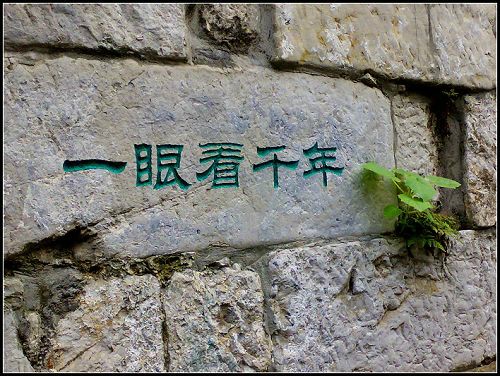2018-01-17 来源: 86Links

Hailing from northern China, Xiaolong says that by this time, it would be snowing heavily back in my home. Whereas Xiaozhi, who comes from southern China, says, “Snow? That’s non-existent at my place. We can just wear autumn clothes there.”
The temperatures in northern and southern China can differ so greatly. Of course, other than the difference in weather, each region also differs in terms of eating habits, cultures and traditions.
Since the differences are so great in southern and northern China, what actually ties them closely together? Where do the north and south intersect?
Before answering those questions, I would like to ask you a question. Do you remember our 86Insights post on “1794 Kilometres: The World’s Longest Canal, Born Because of His Dream”?
As we mentioned earlier, an emperor called Yang Guang built the 1794km canal connecting the south to the north 1400 years ago. This canal is split into two sections: one section stretches from Beijing to the Yangtze River while the other ranges from Hangzhou to Yangtze. Both sections of the canal meet and connect in Yangtze, forming the world’s longest canal, the Beijing-Hangzhou Grand Canal.
The intersection between the Grand Canal and Yangtze is also the best spot to divide Jiangnan and Jiangbei, which is the melting pot for the northern and southern cultures. This melting pot has an imposing name: Zhenjiang. Zhenjiang, which can be broken down in Chinese to “Stablise” and “Yangtze”. We see it in greater detail when we open up China’s map: Zhenjiang’s Xijin Ferry is the intersection point between the Grand Canal and Yangtze.
Actually, Xijin Ferry was formed 1800 years ago. In the following 400 yers, Xijin Ferry progressively became an important hub along the Yangtze. Eventually the construction of the Grand Canal intersected the Yangtze, forming a golden cross-waterway.
As you know, throughout the various dynastic eras in ancient China, the Jiangnan region was the core area where grain, salt and silk was produced in the whole of China. It can be said that if the harvest is ripe in Jiangnan, the whole of China will not go hungry. Hence, the trade route between Jiangnan and Jiangbei was ancient China’s economic pulse.
Then, numerous boats traversed the Xijin Ferry in an endless stream, merchants and boatmen dealt in Xijin Ferry. Countless tavern lights shone on the banks of Xijin Ferry. This scene has been playing for 1400 years.
In this 1400 years, Song dynasty emperors hid secretly here, Ming dynasty emperors worshipped here, imperialists invaded here. As Xijin Ferry was a highly sought-after military ground, it was tightly intertwined with the fates of dynasties.
In this 1400 years, Meng Haoran, Bai Juyi, Wen Tianxiang, Wang Anshi and many other poets from different eras left poems here that are enjoyed for millennia. Even Marco Polo from Italy set sail and landed here.
Within this 1400 years, northerners moved southwards here and southerners traded here. The cultures from Jiangnan and Jiangbei melded together here. The accents and traditions of the north and south were fused here. One might ask another, are you here to sell wares to the north, or migrating to the south? He might answer, I’m staying here and not leaving.
After 1400 years, due to geological changes in the Zhenjiang region around the Grand Canal, the Yangtze was diverted. The Xijin Ferry was buried with mud and sand, eventually becoming land. But more than 1000 years ago, the roads built along the cliffs of Xijin Ferry have already developed into historical streets that have condensed millennia.
This street is the most well-preserved ancient street in the vicinity of Xijin Ferry. The street is 1000m in length and preserves the traces of ancient Tang dynasty. The merchant booths and mansions of Xijin Ferry old street still retains the architectural stylings from hundreds of years ago. As you walk along this ancient street, you will gasp at the passing of age on the stone tiles beneath your feet, the quaint ferry store, unique pot covers, antique teahouses and the life-saving clubs that can only be found in Xijin Ferry.
As the wheels of history continue to turn, the buzzing atmosphere of the Xijin Ferry in its heyday no longer exists. What remains is the quiet sense of the vicissitude of passing millennia in the Xijin Ferry by observing every store, every stone tile, every scene, every building, every façade and every person.
(The pictures from this article are retrieved from the internet.)
Chinese:
大家好~ 过几天就是圣诞了,不知道你们那里下雪了没?我在86insights的上海办公室,听同事们讲述各自家乡不一样的12月。
来自中国北方的小龙表示,这时候我们家那边早已下大雪了。而来自中国南方的小智却说,下雪?在我们那边是不存在的。这会在我们那穿件秋衣就行了。
瞧,中国的南方、北方气温差异竟这么大。当然,除了天气差异,还有饮食习惯、文化习俗,中国南北也各有特色。
既然中国的南方和北方差异这么大,那是什么将南北紧密联系起来的呢?南方和北方的交界又在哪里呢?
在回答这些问题前,我想问你:还记得86insights之前推送的《1794千米的世界上最长运河,只因他的“梦想”而诞生。》?
我们之前讲过,1400年前,一个叫杨广的皇帝开凿了,南北长达1794千米的运河。这条运河分两段:一段是从北京到长江,另一段是从杭州到长江。两段运河在长江相遇、相连,形成了世界最长运河——京杭大运河。
而京杭大运河和长江的交汇点,就是划分江南、江北的最佳地点,也是北方文化、南方文化的融合点。这个融合点有一个气吞山河的名字——镇江。镇江,镇定长江。我们展开中国地图,更具体地看到:镇江的西津渡就是京杭大运河和长江的交汇点。
其实,西津渡早在1800年前形成。在往后的400年里,西津渡逐步成为长江运河的重要枢纽。后来,随着京杭大运河的开凿,长江与京杭大运河交叉,形成黄金十字水道。处在黄金十字水道上的西津渡,一下子成为江南、江北的咽喉要地。
你知道,在中国古代的很多朝代,江南地区是整个中国生产粮食、食盐、丝绸的核心地带。几乎可以说,只要江南地区的粮食熟了,那整个中国的百姓就可以吃得饱饱的。所以,江南与江北的贸易运输是古代中国的经济命脉。
于是,成千上万的船只在西津渡上川流不息;商人船夫在西津渡上匆匆来往;无数家旅社的灯火在西津渡边上点亮。这样的画面,已在西津渡上演了1400年。
在这1400年里,宋朝皇帝悄悄地藏到这里;明朝皇帝在这里信仰宗教;帝国主义侵略到这里。西津渡作为兵家必争之地,已将自己和王朝的命运紧紧捆绑。
在这1400年里,孟浩然、白居易、文天祥、王安石...中国各个王朝的诗人都在这里留下了传诵千年的诗歌。而来自意大利的马可波罗也曾在西津渡登船、上岸。
在这1400年里,北方人在这里向南迁居,南方人在这里卖货。江南文化与江北文化在这里交融。南北的口音、习俗在这里融合。也许有人问他:你是要向北卖货,还是向南去迁移啊?他回答道:留在这里,不走了。
1400年后,由于京杭大运河镇江段地质变化,长江的江流改道。曾经的西津渡被泥沙淤埋,逐渐地变成陆地。但是,一千多年前,西津渡旁一条沿悬崖峭壁修建的道路,已发展成凝聚千年文明的古街。
这条街是西津渡附近,文化古迹保存最多、最集中、最完好的古街。古街全长1000米,保留了唐王朝以来的历史遗迹。西津渡古街旁的商铺、古宅也依然保持着数百年来的建筑风格。徜徉在这条古街上你会惊叹于脚底千年石板的沧桑、古朴的渡船用店、极具特色的锅盖面、古色古香的茶馆、还有西津渡独有的救生会、救火会。
历史的车轮在不断向前,西津渡当年宏大的气势不复存在。唯有眼前的一铺一石一景,一宅一面一人,在静静地感受西津古渡留下的千年沧桑。
(文中图片源于互联网)